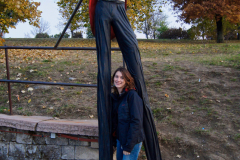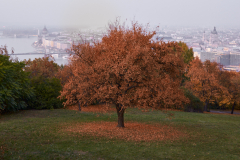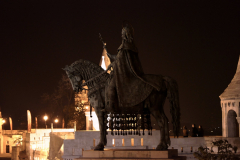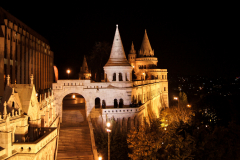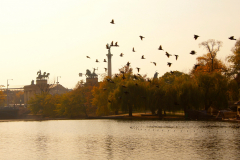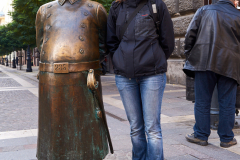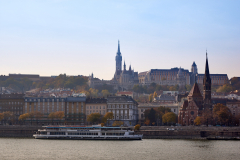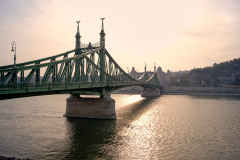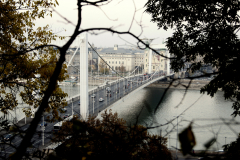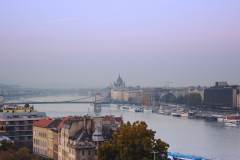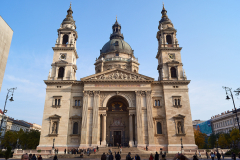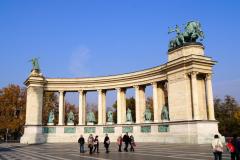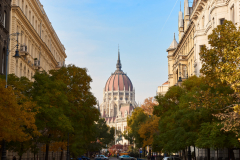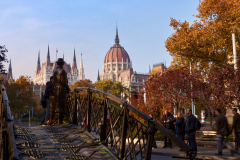
48 hours in Budapest and top spots you cannot miss
It was one sunny November weekend few years back, when we visited Budapest. Back then, young and happy we took the bus. No complaints, no pain in the back, on a budget, but full of energy and readiness to sightsee. We arrived early afternoon on Saturday, left our backpacks at the hostel and started the adventure straightaway. 48 hours in Budapest? Not a problem.
BUDA – DAY 1
Here we were, in Buda part of the city, which lays on the right side of the river. It is believed to be calmer, more sophisticated and cultured comparing to Pest. Countless number of historic places and building are spotted around Buda, not to mention royal family lived there. The walking tour can be easily planned in two ways: from the Gellert’s Hill in direction to Castle Hill, finishing at Vienna’s gate or in reverted way. Starting at Vienna’s Gate with Old Town Hall in front of it, then walking through royal district in direction to Gellert’s Hill and Elizabeth bridge.
GELLERT HEGY
We begun at the Gellert Hegy, high hill in memory of bishop Gellert, who wanted to turn Hungarian back to Christianity. His trial was not successful. Gellert, thrown from hill by pagans, ended up in Danube river. Nowadays, Gellert statue stands there to commemorate him in gratitude.
Even though full of energy, I need to admit that Gellert Hegy with Citadel is quite difficult to reach. Countless number of stairs to step onto or steep hills to get through might be tiring. Once there, the beautiful view to the Millenium Bridge and the city is… covered by smog. It is suspended above the city like a big floating cloud. So just imagine how beautiful the view could be, if there were less fuel consumers. With height, the city noise seemed to be louder. Despite all that, a sunny morning would be a good time for taking photos. Smoggy or not, the view might be irresistible.

CASTLE HILL
We decided to stay on the Buda side and walk along the river until we finally got to the castle hill. From the Gellert Hegy it was around 15 minutes on foot. It’s also possible to take a tram.
Everything we see today on the castle hill is what remained after Second World War and Turkish attacks. Dating back to XIII century, makes the castle hill the oldest district in the whole Budapest. During 1541-1686, Turkish monarchy left a footprint from their stay on the castle hill, basically by building baths in all accessible places and changing churches into mosques. Unfortunately most of the medieval buildings were demolished during that time too. Beginning of XVIII century and the years after were devoted to rebuilding and renovating that area. It all dissolved into a thin air, because in XX century Germans attacked and most of the historic buildings were bombarded and turned into dust. Everything what was left was renovated, reconstructed and rebuilt.

WHAT’S THERE
Nowadays the castle hill seems to be pretty quiet, but filled with tourist wandering with maps and searching for desired monument or object. The area is huge, the whole royal district is fulfilled with museums like Museum of Budapest History, Museum of Contemporary Arts or historic places like Hungarian National Gallery or National Library. What is more, you can find there: Mathias’s fountain, the Old Town Hall, and a sole Maria Magdalena’s Tower, which is what was left after the Christian church. Basically, everything you need to see is cumulated in one place.
FISHERMAN’S BASTION
It would be a sin not to mention the Fisherman’s bastion and Neo Gothic Mathias church. Both breath-taking, marvellous constructions. Fisherman’s bastion with its pseudo gothic architecture does not recall any other historic building in Budapest, it’s unique and unquotable…like a castle from a fairy tale. This monument, built in XIX century, without any doubt will make an impression on you. It was commonly known as defensive wall. However, it’s believed that the Fisherman’s bastion was named after a small fish market, which was situated next to the Cathedra. Thanks to Danube river, traders could provide fresh merchandise every day.
An amazing Parliament, situated on the other side of the Danube river can be viewed from bastions’ windows. The best effect is at night, when it is lit.





MATHIAS CHURCH
Mathias church is definitely top rated monument. You should put it on your MUST-SEE list. The Church is situated in the centre of the castle hill district. The peaked tower with its 60 meters makes impression on its own. The church was named after king Mathias Korwin, however it is sacrificed to Virgin Mary, the patron of Hungary.
Unfortunately as the dusk, chill and fatigue came to us, we slowly head back to the hostel. We walked, not only because we could still admire the beauty of the city a bit longer, but also because we were on a budget. Every forint spent counted.


PEST – DAY 2
The second and the last day of our journey was dedicated to “Pest” part of Budapest. Pest lies on the left part of Danube river and is known from nightlife, high end restaurants and elegant shops. It is also a part, where Hungarian Parliament or St. Stephen’s Basilica are situated. Pest is much bigger than Buda, it takes 2/3 of Budapest itself, in connection it is also more populated.
OUR ITINERARY
The initial plan was to visit the following: Parliament, Freedom Square, Hungarian Opera House, St. Stephen’s Basilica, Hungarian National Museum and the Flea Market.
HEROES SQUARE
It turned out I omitted a great historic place, namely Heroes Square. I would be really disappointed leaving Budapest without seeing that huge area devoted the most valorous and brave men in the history of Budapest and Hungary. And so, we fixed the plan and head straight there. Following Andrassy street, which is quite famous for the European Embassy residences, will lead you straight to the square. Enormous monuments, standing and watching from heavens were built on the shape of a half-circle. In the middle stands out 36 meters high pillar with archangel Gabriel. On both sides of Heroes Square there are two buildings: the Gallery of Arts and Museum of Arts. Behind the Heroes Square is located Varosliget, vast green area. It’s a park for tired tourists, family with children or citizens who wants to get away from the bustle and noise of the city life. After visiting the square with park, we step onto metro and went directly to Opera House. Our primary plan was completely reversed, but didn’t cause any harm.




HUNGARIAN STATE OPERA HOUSE
Although I saw Hungarian State Opera House only from the outside I wasn’t disappointed. The building is maintained in Italian Renaissance style with famous composer statues on its terrace. It was first opened for public on the September 27, 1884 and was designed by a famous Hungarian architect Miklos Ybl in 1875. It was closed in 1981 in order to renovate the edifice and re-opened in 1984, a hundred years after the first opening.



ST. STEPHEN BASILICA
From the Opera House it is not far to the St. Stephen Basilica, the distance can be covered on foot. Vast square precedes the entrance to the Basilica, a 96 meters high building. It took 55 years to finish what was started in 1851. The delay was caused by collapse of the dome in 1868, which forced builders to start from the ground. I was also surprised to hear that no other building can be higher than the Roman Christian Basilica, some kind of superstition or prejudice maybe…? The Basilica’s style is Neo Classical, it is built on Greek cross with cupola in the centre.

FREEDOM SQUARE
The next stop on our trip was Freedom Square, another important historic place. You might wonder why it was called a freedom square. Actually, response is connected with Hungarian Rebellion. Below the square used to be barracks and prison, where many Hungarian patriots were held. It is also essential to remember that it was a place of execution of Hungarian fighters. Their aim was to retrieve freedom. Nowadays you can find there an American Embassy and Hungarian television house. I would also like to point out an Soviet Monument, which was built in order to bear in mind the Red Army backup during the Second World War.
THE PARLIAMENT HOUSE
At the very end we kept so called Országház, the Parliament House. From the first moment I saw the Parliament I couldn’t wait until we finally come closer. Innumerable amount of peaked towers, hundreds of windows, enormous cupola right in the middle seem to be a bit of exaggeration, but it fits together and make a coherent entirety. The Parliament House is gigantic, it’s surface is 17.000 square meters, 268 meters length and 123 meters width. From the outside, beside towers it is decorated with statues, while inside is ornamented with paintings. What’s interesting is that even though the construction started in 1885 and finished in 1904, the first conference was called in 1896 because of the 1000th anniversary of the city. To build this incredible building about 1000 people were hired, half a million precious stone and 40 million bricks were used. I know I will repeat myself, however when visiting Budapest you really need to see the Parliament House.







THERE’S MORE
Certainly a better location to spend some time surrounded by a nature is Margaret’s island, you will have a 500 meters wide area to calm and slow down a little bit. Island is quite close from the city centre, it is linked with the mainland through two bridges, one from the north, the other from the south. Margaret Island is known from baths, swimming pools and a botanical garden. Unfortunately, we didn’t have enough time to get there, but who said we won’t go to Budapest again?
FREE NATIONAL MUSEUM
We found however time to get to the Hungarian National Museum hoping to experience a short history lesson. But don’t be deluded, exhibition is not for free as one “guide” mentioned. The entrance charge was 1000huf. Unluckily we were out of money so the only choice we had was another “free“ walking tour. We designated around 2 hours for the museum, yet we spent few minutes on museum’s stairs just to rest a little bit.
FLEA MARKET
Finally, it turned out that I wasn’t prepared at all. One last place I wanted to see was closed on Sundays. Flea market known for its unique and distinguished masterpieces, souvenirs and rare atmosphere had to wait till the next time. But if you want to buy yourself souvenir different that the other found around the city in the souvenirs shops, don’t make my mistake. Go to Flea market during the week, the sooner the better of course.
BRIDGES
Budapest as the city divided by the river is famous for its bridges. Two separate parts Buda and Pest were linked in 1849 for the first time. The construction of Chain Bridge took 9 years, it is 380 meters long, the iron elements weight 5194 tons. Spare a moment to gaze at 4 lions, 2 on each side of the bridge. Their significance is symbolic, lions are guardians of the city. Thorough the city you will unquestionably run into more lions monuments. I wonder how many did you count?
CHAIN BRIDGE
The chain Bridge just as impressive at daylight is even more fascinating at night. Glow and brightness of the lights illuminate in the water. It looks stunning, whether only night was longer….
ELIZABETH BRIDGE
Elizabeth bridge can be viewed from the Gellert Hegy, it was built right after the Liberty bridge, the construction started in 1897. Present-day bridge vary from the original design. The bridge is 378.6 meters long, with 11 meters wide driveway and 3,5 meters wide pavement. Notice that the pillars supporting the portal are placed onto the river bank, not as usual in the river bed.

LIBERTY BRIDGE
I really believe that Liberty Bridge is a work of art, it is the third and one of my favourite among Budapest’s bridges. What did I like about it? First of all the green colour, which makes it so diverse from the others, second of all adornment, and last but not least the surrounding. Mister Janos Feketehazy, a designer, made a really good project in 1894. Virgil Nagy helped in designing the ornamentation. It was his idea to decorate portals’ peaks with falcon like bird called Turul, known from ancient Hungarian mythology. As the legend says, Turul was supposed to bring Hungarian in the place they live now. It is quite an important symbol.



ACCOMMODATION
I was trying to find the cheapest accommodation ever and I think I succeed. Hungary is not expensive in general. The cheapest accommodation you can find in Budapest costs around 30 euros per night. But try to search for the one with some extra features, like baths or wellness. Budapest has also more fabulous and luxurious options. But it all depends on your preferences and budget of course. Check the full list here.
IS THIS THE END?
And that is really it, I hope your “expedition” to Budapest will be enlightening and didactic, you will discover the mysteries and secrets of the city settled in 1872/3. I expect you to have fun while exploring 525,16 square kilometers of the city, one of the biggest metropolises in the Central Europe and eighth on the list of the most populated city. So use the guide wisely and don’t get lost. And of course find some time to relax at one of Budapest’s baths, so your visit would be the most memorable and superb trip you have ever had. One last piece of advice: eat goulash- whenever you want and try to cook the same at home.
Share this:

Skiing near Brno: Ski fajtuv kopec

New Castle Adamov
You May Also Like

The #1 Unesco site: Lednice-Valtice Complex by bike
July 3, 2013
Brno on bike: one day trip
May 10, 2013



